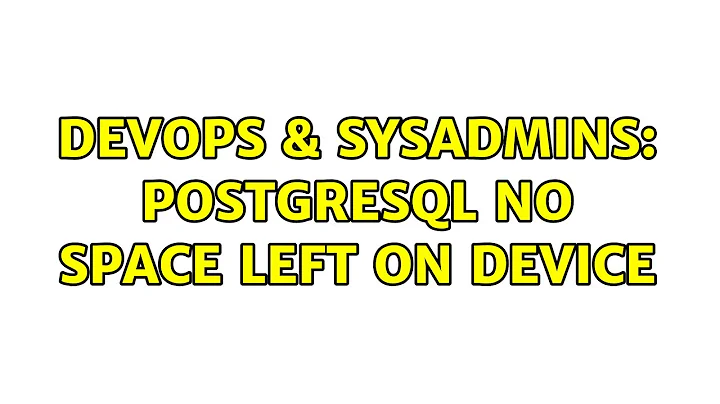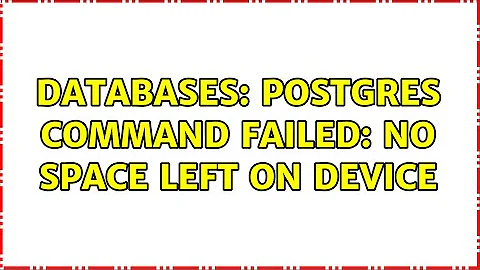PostgreSQL - Could not extend file No space left on device. HINT: Check free disk space
Your server is badly partitioned. This is not entirely your fault; rather, the default RHEL/CentOS settings are quite misleading in my opinion.
Let's start from the description on the pvs; vgs; lvs command entered above. They are all related to LVM2, a Logical Volume Manager which, in short, enable you to create "flexible", resizeable partitions:
pvsshows how the physical disks are attached to the LVM system. You had 2x 200 GB disks, butpvsonly shows 1x200 GB physical device. This means your disks are in RAID1 (mirroring) and they are wholly assigned to LVM (ie: no physical space is unassigned);vgsshows the Volume Group assigned to your physical devices and any usable free space. In your case free space is <4 MB, so basically you have no space free space. The next command explains what is using your space...lvsshows you have two Logical Volumes (think them as partitions): a 50 GB root volume and a ~145 GB home volume. In short, yourrootvolume (where PostgreSQL resides) is way smaller than your needs; rather, yourhomevolume is very large considering how few data (< 5GB) it contains.
To solve the problem, you have two options:
relocate PostgreSQL under the
homevolume, for example under/home/pgsl. I would avoid this because/homeis not the right place for a database and it will cause an administrative burden in the future. Moreover, you need to put SELinux into permissive mode (setenforce 0+/etc/selinux/configediting) to let the relocation work;shrink the
homevolume and enlargeroot. This is easier said than done, especially if you are using XFS (default RHEL/CentOS filesystem), which does not support shrinking.
If and only if your data under home can be trashed / reloaded, you can follow the following steps to DELETE the home volume and enlarging root. Please note that a small error (both mine and your) WILL destroy your data (killing any cats in a ~100 KM range), and so I take NO RESPONSABILITY for the final outcome. If you are unsure, stop here and call a professional sysadmin for support. Ok, let's go ahead; I'll post a command sequence with the relative description:
-
umount /home: this unmount (ie "disable") the home volume; -
lvremove centos/home: this permanently destroy/homeand all its content; -
lvextend centos/root -L +100G: this expand therootvolume by 100 GB; -
xfs_growfs /: assuming you are using XFS, this expand the root filesystem to match the underlying, extended volume. If you are usingext4(which is improbable), you need to issueresize2fs /dev/centos/root.
Related videos on Youtube
Eric Kim
Updated on September 18, 2022Comments
-
Eric Kim over 1 year
I've been inserting data into PostgreSQL DB, and got the error message:
psycopg2.OperationalError: could not extend file "base/16384/61892": No space left on device HINT: Check free disk spaceI am using CentOS 7, and I've checked some of my status on my linux machine:
df -hI'm pretty new to Linux, and based on the result of my
df -hcommand, I could see that Linux storage system works differently than Windows.It looks like PostgreSQL is pushing to
/dev/mapper/centos-root, but it has only 50 GB available.Question 1: How can I change it? How can I assign the extra free space that's available in
/dev/mapper/centos-hometo my~/centos-rootdirectory?Question 2: My machine has two Hard disk, 200 GB each. But according to my
df-hcommand, it looked like I only have 200GB available. Why is this the case? How can I take advantage of full 400GB space?It looks like the problem is that my
/dev/mapper/centos-rootis all filled up. I have inserted nearly 10,000,000 rows of data with 12 columns in PostgreSQL.Question 3: Is this big enough to take up 50GB of space?
Thanks!
Edit: output of
pvs,vgs,lvs-
 shodanshok over 5 yearsPlease post the output of
shodanshok over 5 yearsPlease post the output ofpvs; vgs; lvs -
Eric Kim over 5 years@shodanshok please check the update. Also, what are the significance of each commands?
-
 HBruijn over 5 years@EricKim (almost) every command comes with an online manual that will give you between a hint and an encyclopaedia's worth of information on what the command does and supported switches etc.; try
HBruijn over 5 years@EricKim (almost) every command comes with an online manual that will give you between a hint and an encyclopaedia's worth of information on what the command does and supported switches etc.; tryman pvs,man lvsand the manual for the manual systemman man- but the relevant output of the command sequence shows how much of your physical disk(s) , physical volume and logical volume space is assigned and available
-
-
wazoox over 5 yearsIt would be at least prudent to first have a look at what /home contains before nuking it, and recreate /home and remount it afterwards else problems will probably occur later...
-
wazoox over 5 yearsrun "ls -l /home" and "du -sh /home/*" before destruction (and regrets.
-
wazoox over 5 yearsthen "lvcreate -L10G centos home", "mkfs.xfs /dev/centos/home", mount "/home"
-
wazoox over 5 yearsYou'll probably need to recreate the user home directory you're using to log into the system (because YOU MUST NOT LOGIN AS ROOT). "cp -r /etc/skel /home/user && chown -R user:users /home/user"






